人教版(2019)选择性必修 第三册Unit 1 Art Project课件(共18张PPT)
文档属性
| 名称 | 人教版(2019)选择性必修 第三册Unit 1 Art Project课件(共18张PPT) |
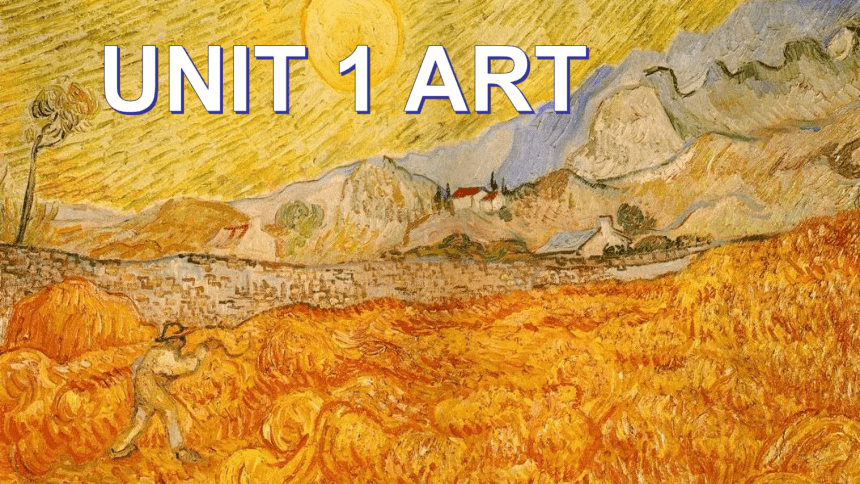
|
|
| 格式 | pptx | ||
| 文件大小 | 4.6MB | ||
| 资源类型 | 教案 | ||
| 版本资源 | 人教版(2019) | ||
| 科目 | 英语 | ||
| 更新时间 | 2024-03-03 09:54:27 | ||
图片预览



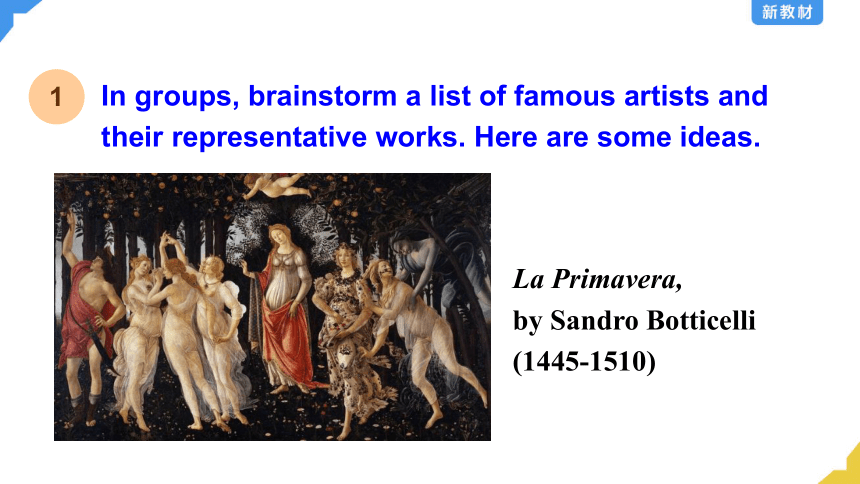
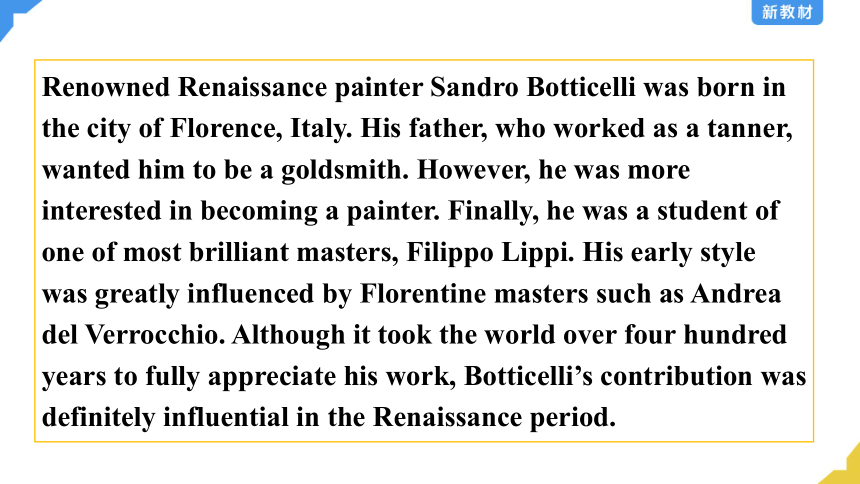
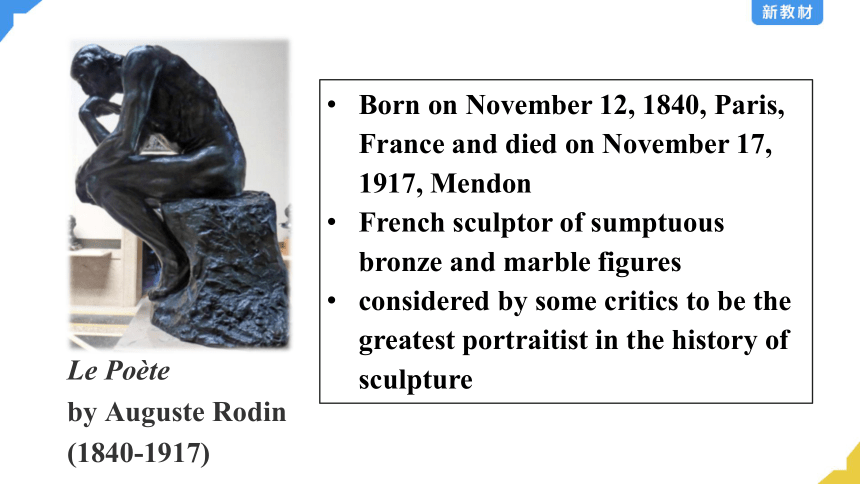
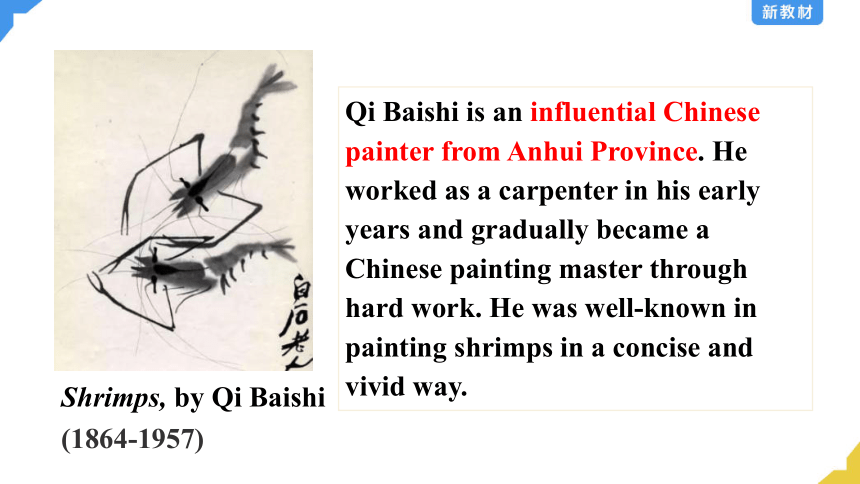
文档简介
(共18张PPT)
UNIT 1 ART
Do a talk show about an artist
To choose an artist and find some information about him or her.
To make a role-play of a talk show which has the famous artist as the guest.
In groups, brainstorm a list of famous artists and their representative works. Here are some ideas.
La Primavera,
by Sandro Botticelli
(1445-1510)
1
Renowned Renaissance painter Sandro Botticelli was born in the city of Florence, Italy. His father, who worked as a tanner, wanted him to be a goldsmith. However, he was more interested in becoming a painter. Finally, he was a student of one of most brilliant masters, Filippo Lippi. His early style was greatly influenced by Florentine masters such as Andrea del Verrocchio. Although it took the world over four hundred years to fully appreciate his work, Botticelli’s contribution was definitely influential in the Renaissance period.
Le Poète
by Auguste Rodin
(1840-1917)
Born on November 12, 1840, Paris, France and died on November 17, 1917, Mendon
French sculptor of sumptuous bronze and marble figures
considered by some critics to be the greatest portraitist in the history of sculpture
Shrimps, by Qi Baishi
(1864-1957)
Qi Baishi is an influential Chinese painter from Anhui Province. He worked as a carpenter in his early years and gradually became a Chinese painting master through hard work. He was well-known in painting shrimps in a concise and vivid way.
Decide on which artist your group is going to talk about.
2
Choose one person to be the talk show host, one person to be the artist, and the remaining members to be a family member, a friend, a teacher, or an art critic. Have each person do research on the artist and prepare notes on what he/she will say.
3
talk show host: questions for the guests
artist: biography (传记) of the artist, philosophy (思想体系) towards art, details about his/her most representative works
family: What was the artist like when he/she was a child or growing up What was it like living with the artist What do they think of the artist’s talent and work
friends: How did they meet the artist What is the artist like as a person What do they think of the artist and his work
teacher: What was the artist like as a student Could he/she imagine that the artist would grow up to be famous
art critic: How is the artist’s work critically received
artist: Can you introduce yourself
What do you think has influenced you the most
What are your representative works
family/friend/teacher:
How is your relationship with the artist
What do you think of the artist
What do you think has influenced the artist the most
What do you think of the artist’s works
art critics: What positive review has the artist received
What negative review has the artist received
What do you think of the artist’s works
Now role-play your talk show before your class.
4
Notes for doing the talk show
Keep in mind that guests may have different opinions as to what the artist is like and how talented he/she was, so they should feel free to disagree and discuss.
If possible, the group should also find large photos or posters of the artist’s representative work to be used as talk show exhibits.
Towards the end of the talk show, the host should go out into the “audience” (i.e., the class) and take questions from the audience.
H: Talk Show Host A: Artist (Salvador Dali)
M: Artist’s mother F: Artist’s father
T: Artist’s teacher C: Art critic
H: Today I am very honoured to welcome the Spanish surrealist artist Salvador Dali to our studio. First, tell us a little about your life and how you first became an artist.
A: At the age of six I wanted to be a cook. At seven I wanted to be Napoleon. And my ambition has been growing steadily ever since. I love art, but painting is really a small part of who I am.
H: Interesting. Confidence is an important quality for an artist! What is your philosophy towards art, and which do you think are your most representative works
A: One should strive for perfection but accept one will never reach it. As for Surrealism, it is destructive, but it destroys only what it considers to be shackles limiting our vision. A key work of mine is The persistence of Memory. In it, I challenge the idea that time is a hard and unchanging thing, symbolised by what some people call my “melting watches”.
H: Fascinating. Welcome also to your mother, Felipa. What was Salvador like growing up
M: He showed a keen interest in art and artistic talent from a young age, so I always tried to encourage him to pursue art.
H: This is Man Ray, a fellow surrealist artist and long-time friend of Dali. How did you first meet Salvador What is he like as a friend
F: We first met in Paris with other surrealist artists. He is a loyal friend and very committed to his art. He always gets everyone’s attention because he is eccentric in what he wears and does. He is fun to be around.
H: Finally, we welcome the respected art critic and author, Luis Romero. How is Dali’s work received critically
C: Although his work is often controversial, behind the outrageous images, there is great artistic skill. He is clearly influenced by Renaissance art styles.
H: Well, thank you all for your time today, and special thanks to Dali for your amazing body of work that has inspired and brought wonder to so many people over the years.
Write a review about your group’s talk show.
UNIT 1 ART
Do a talk show about an artist
To choose an artist and find some information about him or her.
To make a role-play of a talk show which has the famous artist as the guest.
In groups, brainstorm a list of famous artists and their representative works. Here are some ideas.
La Primavera,
by Sandro Botticelli
(1445-1510)
1
Renowned Renaissance painter Sandro Botticelli was born in the city of Florence, Italy. His father, who worked as a tanner, wanted him to be a goldsmith. However, he was more interested in becoming a painter. Finally, he was a student of one of most brilliant masters, Filippo Lippi. His early style was greatly influenced by Florentine masters such as Andrea del Verrocchio. Although it took the world over four hundred years to fully appreciate his work, Botticelli’s contribution was definitely influential in the Renaissance period.
Le Poète
by Auguste Rodin
(1840-1917)
Born on November 12, 1840, Paris, France and died on November 17, 1917, Mendon
French sculptor of sumptuous bronze and marble figures
considered by some critics to be the greatest portraitist in the history of sculpture
Shrimps, by Qi Baishi
(1864-1957)
Qi Baishi is an influential Chinese painter from Anhui Province. He worked as a carpenter in his early years and gradually became a Chinese painting master through hard work. He was well-known in painting shrimps in a concise and vivid way.
Decide on which artist your group is going to talk about.
2
Choose one person to be the talk show host, one person to be the artist, and the remaining members to be a family member, a friend, a teacher, or an art critic. Have each person do research on the artist and prepare notes on what he/she will say.
3
talk show host: questions for the guests
artist: biography (传记) of the artist, philosophy (思想体系) towards art, details about his/her most representative works
family: What was the artist like when he/she was a child or growing up What was it like living with the artist What do they think of the artist’s talent and work
friends: How did they meet the artist What is the artist like as a person What do they think of the artist and his work
teacher: What was the artist like as a student Could he/she imagine that the artist would grow up to be famous
art critic: How is the artist’s work critically received
artist: Can you introduce yourself
What do you think has influenced you the most
What are your representative works
family/friend/teacher:
How is your relationship with the artist
What do you think of the artist
What do you think has influenced the artist the most
What do you think of the artist’s works
art critics: What positive review has the artist received
What negative review has the artist received
What do you think of the artist’s works
Now role-play your talk show before your class.
4
Notes for doing the talk show
Keep in mind that guests may have different opinions as to what the artist is like and how talented he/she was, so they should feel free to disagree and discuss.
If possible, the group should also find large photos or posters of the artist’s representative work to be used as talk show exhibits.
Towards the end of the talk show, the host should go out into the “audience” (i.e., the class) and take questions from the audience.
H: Talk Show Host A: Artist (Salvador Dali)
M: Artist’s mother F: Artist’s father
T: Artist’s teacher C: Art critic
H: Today I am very honoured to welcome the Spanish surrealist artist Salvador Dali to our studio. First, tell us a little about your life and how you first became an artist.
A: At the age of six I wanted to be a cook. At seven I wanted to be Napoleon. And my ambition has been growing steadily ever since. I love art, but painting is really a small part of who I am.
H: Interesting. Confidence is an important quality for an artist! What is your philosophy towards art, and which do you think are your most representative works
A: One should strive for perfection but accept one will never reach it. As for Surrealism, it is destructive, but it destroys only what it considers to be shackles limiting our vision. A key work of mine is The persistence of Memory. In it, I challenge the idea that time is a hard and unchanging thing, symbolised by what some people call my “melting watches”.
H: Fascinating. Welcome also to your mother, Felipa. What was Salvador like growing up
M: He showed a keen interest in art and artistic talent from a young age, so I always tried to encourage him to pursue art.
H: This is Man Ray, a fellow surrealist artist and long-time friend of Dali. How did you first meet Salvador What is he like as a friend
F: We first met in Paris with other surrealist artists. He is a loyal friend and very committed to his art. He always gets everyone’s attention because he is eccentric in what he wears and does. He is fun to be around.
H: Finally, we welcome the respected art critic and author, Luis Romero. How is Dali’s work received critically
C: Although his work is often controversial, behind the outrageous images, there is great artistic skill. He is clearly influenced by Renaissance art styles.
H: Well, thank you all for your time today, and special thanks to Dali for your amazing body of work that has inspired and brought wonder to so many people over the years.
Write a review about your group’s talk show.
